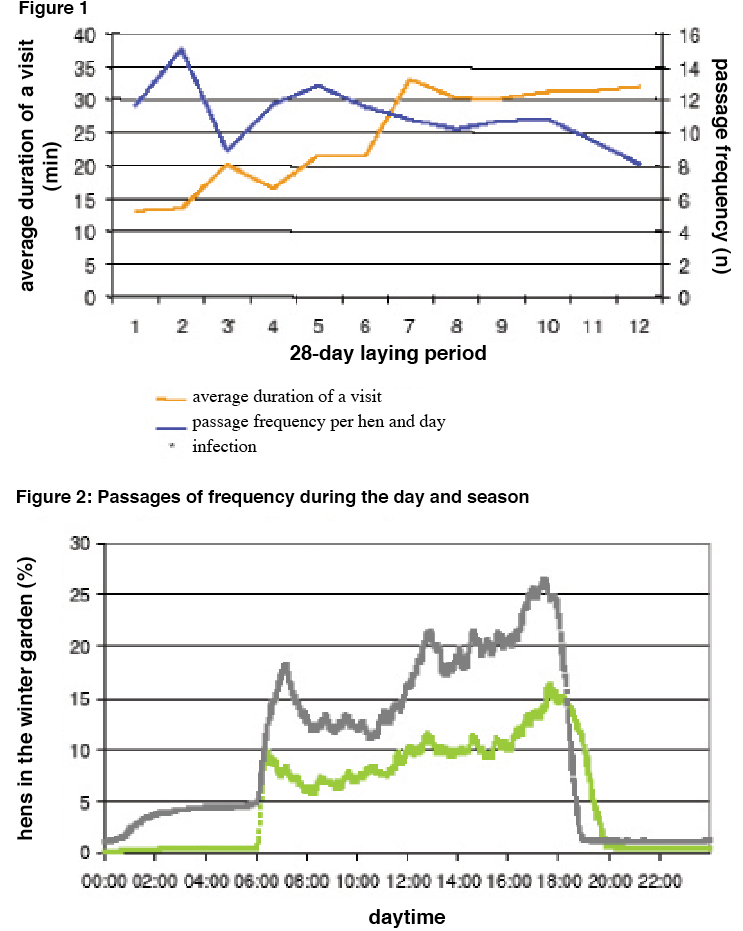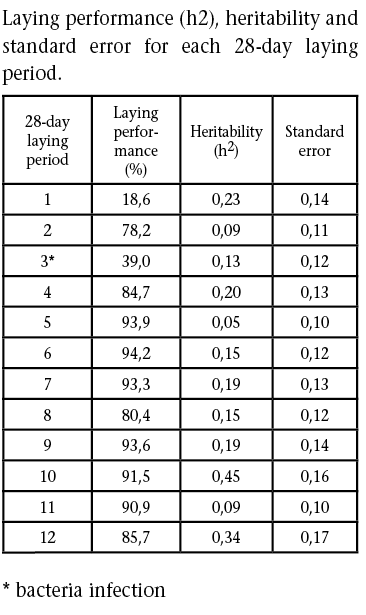
Free-Range Behaviour
By Wiebke Icken Lohmann Tierzucht GmbH
Features New Technology ProductionA new study may point the way to breeding laying hens
With the aid of a new transponder technology, the free-range behaviour
and laying performance of 272 Lohmann Silver hens were tested
simultaneously.
New study may point the way to breeding laying hens to be more accepting and productive in free-range conditions
 |
|
| A study of laying hens with access to a free-range “winter garden” has shown a big variation from hen to hen. Some hens merely glanced outside while others stayed nearly day and night outside. Advertisement
|
With the aid of a new transponder technology, the free-range behaviour and laying performance of 272 Lohmann Silver hens were tested simultaneously. Therefore, Lohmann Tierzucht GmbH investigated together with the Bavarian State Research Centre for Agriculture, Institute for Agricultural Engineering and Animal Husbandry, Electronic Pop Holes (EPH) and Funnel Nest Boxes (FNB).
These systems made it possible to record automatically each separate visit to the free-range area as well as the egg number by every single hen in the flock. The hens were housed in an aviary with an adjoining winter garden at the experimental station Thalhausen (Technical University of Munich).
To identify each single hen in the EPH and FNB, every hen was tagged with a transponder on one leg. During the whole investigation period of one year, the winter garden was continuously accessible for the hens. The frequency of passages (number of passages between the in- and the outside area) and the duration of stay in the free-range area of each hen was recorded daily.
A large fraction of the hens (35 per cent), did not use the winter garden at all. The percentage of hens that used the winter garden (at least once in a 28-day period), increased during the observation period. As soon as a hen was familiar with the winter garden, she visited the free-range area nearly every day. Expected effects, like a reduction of the share during autumn and winter, were not found.
The highest number of passages through the EPH was registered in the second laying period (15 passages per hen and day). Thereafter, the frequency decreased from a level of 13 passages in the fifth laying period to eight passages in the 12th laying period. The average length of stay in the winter garden showed an antagonistic trend to the frequency of passages.
 |
|
 |
At the beginning of the observation period, the average visit to the winter garden had a duration of 14 minutes, whereas from laying period seven to the end of the observation, a single stay took an average of more than 30 minutes.
The number of passages and the duration of stay in the winter garden showed a big variation from hen to hen. There were some hens that returned to the barn after a short glance into the winter garden, whereas others stayed nearly day and night outside. Most of the passages through the EPH were registered in the morning between 6 a.m. and 8 a.m. as well as in the afternoon between 4 p.m. and 5 p.m. The average stay in the winter garden per hen and day was about 21/2 to four hours.
At four o’clock in the morning, the artificial light in the barn was switched on and at 8 p.m., it was switched off. From 8 a.m. onwards, the hens were looking intensively for the FNB to lay their eggs. The laying performance of the hens was calculated for each 28-day laying period, beginning with the first correct registered egg in the FNB. A
bacterial infection in the third laying period caused the very late peak of the laying performance (94.2 per cent) in the sixth laying period. The laying performance stayed on a slightly lower level thereafter, with a drop to 86 per cent during the 12th laying period. The estimated heritabilities for the egg number were generally at a low level, varying from one laying period to the next.
Genetic and phenotypic correlations were estimated for the traits: frequency of passages, length of stay in the winter garden and laying performance. A highly positive correlation between the frequency of passages and the length of stay were expected and validated by the close relationship between both traits. Negative genetic correlations were estimated between both parameters for the ranging behaviour and the laying performance. Only a slightly negative trend could be found in the correlation between the traits: frequency of passages and laying performance, whereas a moderate negative correlation (rg = – 0.34) was detected between the traits: length of stay in the winter garden and laying performance.
Until now, no literature could be found to describe the correlations between the two free-range parameters (frequency of passages and length of stay) and the laying performance, like in this investigation. Therefore, the EPH and FNB first showed the possibility to simultaneously record the free-range behaviour and egg number for each hen in a group housing system, with a justifiable effort under field conditions.
The analysis showed interesting information and very promising results for layer breeding, which should be confirmed in further investigations. Furthermore, it is being reviewed, as to how the recorded data could be integrated into the current breeding program to improve and sustain the nest and free-range acceptance. n
Print this page